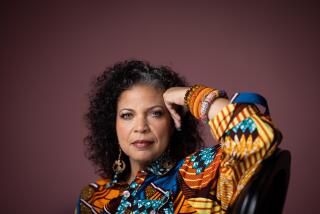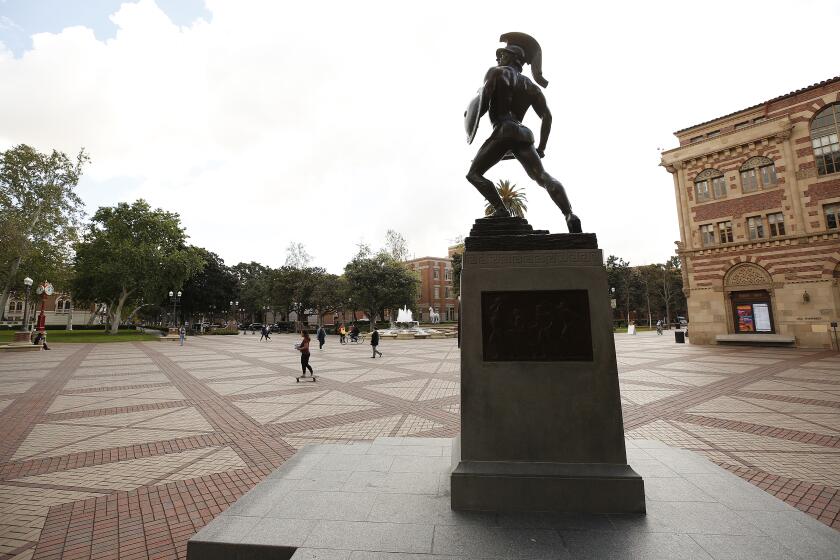Defusing black-brown tension
Today’s question: Is black-brown tension in L.A. something to be concerned about? Previously, Hutchinson and Hicks debated the use of eminent domain to improve commerce, police-minority relations and the quality of South L.A.’s political leadership.
Silence from black and Latino officials
Point: Earl Ofari Hutchinson
The question is not whether black and brown tensions in L.A. are something to be concerned about, but what can be done to reduce the tensions. A recent Los Angeles County Human Relations Commission report found that hate crimes have jumped to a five-year high in the county. The bulk of the crimes were committed by blacks and Latinos and against each other -- a loud alarm that racial tensions in some parts of L.A. County have escalated to a dangerous point.
The reasons for the tension and violence are well known. They are competition for a scarce supply of low-end jobs and school and health services, jitters over illegal immigration, gang turf battles, language differences and, yes, racial and cultural bigotry on both sides. High on that list is the abysmal and shameful failure of black and especially Latino elected officials to leap to the front line in the fight to promote black-Latino harmony.
I’ve lost count of how many times I have implored Latino elected officials, organizations such as the Mexican American Political Assn. and La Raza Unida and Latino church and business leaders to dialogue at our weekly Los Angeles Urban Policy Roundtable. I’ve lost count of how many times I and a small but gutsy band of determined black activists have stood in front of schools and at street corners after violent clashes between blacks and Latinos, calling for unity and dialogue. And every time, I have wondered why Latino leaders weren’t standing with us. I’ve lost count of the times I have begged Mayor Antonio Villaraigosa to speak out on black and brown violence and jump-start programs that provide resources for job creation and gang violence prevention programs. The response has been a deafening silence.
I and others have made the same pitch to black elected officials and religious leaders -- and have gotten the same deafening silence. I even challenge you, Joe, to drop your stand-above-the-fray posture that belittles our efforts at establishing community peace and to roll up your sleeves, get down in the trenches and help us. The silence from black and Latino elected officials and mainstream leaders has cost lives, deepened suspicion and ill will and further soured black-brown relations in some neighborhoods.
The picture, however, is not total doom and gloom. Following brawls between black and Latino students at Jefferson, Locke and a handful of other high schools, black and Latino parents, teachers and administrators organized rallies, marches and speak-ins on the violence, causing some tension to be loosened. But this was a people-to-people effort rather than one led by elected officials.
Los Angeles police Chief William Bratton has recently admitted the possibility of racial motives in some of the black and Latino violence, while L.A. County Sheriff Lee Baca has screamed loudly that such violence is a potentially explosive problem. They are the rare exceptions among public officials. The question, Joe, is this: Will you join me in challenging others to speak out?
Earl Ofari Hutchinson is an author and political analyst. His new book is “The Ethnic Presidency: How Race Decides the Race to the White House.”
The illegal immigration elephant
Counterpoint: Joe R. Hicks
This is an area of discussion, Earl, where the differences between you and I tend to narrow somewhat -- but not completely.
As you say, the real issue isn’t that there is a problem but rather what can be done about it. You seem frustrated that Latino elected officials and community leaders have ignored your calls to engage in “dialogue.” Indeed, their ambivalence on this issue has been shameful. But as someone who led this city’s Human Relations Commission (separate from the county’s panel), I’ve lost track of the time we spent constructing “dialogues” and “conflict resolution” sessions. Guess what? As much research has shown, they simply don’t work.
In fact, all of the so-called multicultural approaches that had been adopted by government, public schools and even the corporate world have had an adverse effect. Under intense pressure from people like you, Earl, the more race and cultural pride have been emphasized and “differences” bizarrely celebrated, the more conflict has become an expression of that racial pride. South L.A.’s public schools are a prime example; they’ve seen several nasty brawls between black and brown students, all of whom seemed intensely proud of their respective identities. Similarly, jails are hotbeds for racial conflict, and candidates for the Los Angeles Board of Education have run campaigns with the message that the board ought to “look like the majority of students.”
Calls for “dialogue,” no matter how well-intended, are simply not what’s needed. I quickly realized this during my lengthy efforts in places such as Harbor Gateway, Hawaiian Gardens, Pacoima and Venice, among other places where the bullets have been flying. The No. 1 issue is the omnipresence of gang members, which makes everyday life a dicey proposition. It is an area in which law enforcement has a critically important role to play.
But there is another issue that you quickly pass over -- the effect of illegal immigration. Harvard economist George Borjas estimates that illegal immigration accounted for a 7.4% decrease in the employment rate of unskilled black males from 1980 to 2000. The local effect has been stunning. The number of blacks employed as janitors in L.A. went from roughly 2,500 in the late 1970s to only 600 by 1985. While traditional black leadership has been largely silent on this issue, this topic has been the buzz of every black barbershop in South L.A. for more than a generation. Illegal immigration combined with rampant gang violence has resulted in “black flight.” L.A.’s black population has declined by about 123,000 in the last 15 years, while the Latino population, propelled by illegal entry and a high birth rate, has grown by more than 450,000.
Although I won’t join you in the call for dialogues and street-corner prayers, I will continue to be a voice for reason and an advocate for appropriate actions to deal with black-brown tensions. Toward that end, we must enforce workplace sanctions against illegal labor; end protections for illegal immigrants; make the eradication of gangs a city budgetary priority by making sure law enforcement has the tools and personnel to do the job; and talk openly and honestly about the role of race in L.A.’s gang warfare, which has taken all too many young lives. One such life was that of 17-year-old Jamiel Shaw II, killed by someone who shouldn’t have even been here.
Joe R. Hicks is vice president of Community Advocates Inc. and a KFI-AM (640) talk-show host. He is a former executive director of the Los Angeles City Human Relations Commission and the Southern Christian Leadership Conference.
| | | Day 4 |
More to Read
A cure for the common opinion
Get thought-provoking perspectives with our weekly newsletter.
You may occasionally receive promotional content from the Los Angeles Times.










